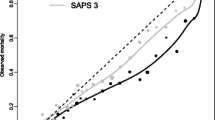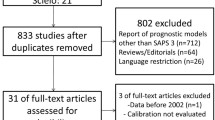Abstract
Objective
To assess the validity of SAPS II (new Simplified Acute Physiology Score) in a cohort of patients admitted to a large sample of Italian intensive care units (ICU).
Design and setting
The ability of the SAPS II scoring system to predict the probability of hospital mortality was assessed with calibration and discrimination measures obtained using published coefficients. A new logistic regression equation was then developed and further formal calibration and discrimination measures were estimated for the customized model.
Patients
From the 2202 consecutive patients recruited during a 1-month period in 99 ICUs, a total of 1393 patients were included in this validation study.
Results
When the parameters based on the standard model were applied, the expected probability of mortality did not fit those actually observed in the cohort (p<0.001), although it showed satisfactory discrimination (area under the receiver operating characteristic curve=0.80). Such lack of fit yields an overall under prediction of mortality (observed/expected ratio=1.14) that reflects a uniform pattern across a preselected set of subgroups. Customization allowed new mortality estimates to be calculated, with satisfactory calibration (p=0.82) and a more uniform pattern across subgroups.
Conclusions
SAPS II maintained its validity in an independent sample of patients recruited in a large network of Italian ICUs only after appropriate adaptation (first-level customization). Whether the determinants of this relatively poor performance are related to differences in unmeasured case-mix, methods of application, or quality of care delivered is a matter for discussion that cannot be solved with the data presently available. However, these findings suggest that caution is warranted before implementing the standard SAPS II scoring system parameters outside formal research projects.
Similar content being viewed by others
References
Apolone G, Brazzi L, Pesce C (1992) Studio multicentrico sui profili di cura e sull' outcome di pazienti ricoverati in reparti di Terapia Intensiva italiani. Minerva Anestesiol 58: 1297–1303
Apolone G, Melotti R, Repetto F, Iapichino G (1994) Cost containment: Europe, Italy. New Horizons 2: 350–356
GiViTI Investigators (1994) The intensive care in Italy: results from a multicentric study. Clin Intensive Care 5 [Suppl]: 116
Apolone G, Brazzi L, Fasiolo S, Iapichino G, Melotti R, Serra L (1993) The epidemiology of intensive care in Italy. Results from GiViTI — Gruppo italiano Valutazione interventi in Terapia Intensiva. In: Gullo A (ed) Anaesthesia, pain, intensive care and emergency. APICE Editor, Trieste, pp 709–721
Apolone G (1994) Sedation in Italian intensive care units: GiViTI data. In: Gullo A (ed) Anaesthesia, pain, intensive care and emergency medicine. Fogliazza Editore, Milano, pp 93–105
Le Gall J-R, Lemeshow S, Saulnier F (1993) A new Simplified Acute Physiology Score (SAPS II) based on a European/North American multicenter study. JAMA 270: 2957–2963
Lemeshow S, Teres D, Avrunin JS, Pastides H (1987) A comparison of methods to predict mortality of intensive care unit patients. Crit Care Med 15: 715–722
Schuster DP (1992) Predicting outcome after ICU admission. The art and science of assessing risk. Chest 102: 1861–1870
Lemeshow S, Le Gall J-R (1994) Modeling the severity of illness of ICU patients. A systems update. JAMA 272: 1049–1055
Hosmer DW, Lemeshow S (1989) Applied logistic regression. Wiley, New York
Hadorn DC, Keeler EB, Rogers WH, Brook RH (1993) Assessing the performance of mortality prediction models. Rand, Santa Monica
Le Gall J-R, Lemeshow S, Leleu G, Klar J, Huillard J, Rué M, Teres D, Artigas A, for the Intensive Care Unit Scoring Group (1995) Customized probability models for early severe sepsis in adult intensive care patients. JAMA 273: 644–650
Hanley JA, McNeil BJ (1982) The meaning and use of the area under a receiver operating characteristic (ROC) curve. Radiology 143: 29–36
Rapoport J, Teres D, Lemeshow S, Gehlbach S (1994) A method for assessing the clinical performance and cost-effectiveness of intensive care units: a multicenter inception cohort study. Crit Care Med 221: 1385–1391
Hosmer DW, Lemeshow S (1996) Confidence interval estimates of an index of quality performance based on logistic regression models. Stat Med (in press)
Knaus WA, Draper EA, Wagner DP, Zimmerman JE (1985) APACHE II: a severity of disease classification system. Crit Care Med 13: 818–829
Lemeshow S, Teres D, Avrunin JS, Gage RW (1988) Refining intensive care unit outcome prediction by using changing probabilities of mortality. Crit Care Med 16: 470–477
Rowan KM, Kerr JH, Major E, McPherson K (1993) Intensive Care Society's APACHE II study in Britain and Ireland — II: outcome comparisons of intensive care units after adjustment for case mix by the American APACHE II method. BMJ 307: 977–981
Abizanda R, Rodriguez MT, Ferrandiz A (1994) Evaluation of SAPS II mortality prediction capability. Comparison with SAPS I and APACHE II. Intensive Care Med 20: 51
Zhu BP, Lemeshow S, Hosmer DW, Klarm J, Avrunin J, Teres D (1996) Factors affecting the performance of the models in the mortality prediction model and strategies of customization: a simulation study. Crit Care Med 24: 57–63
Féry-Lemonnier E, Landais P, Loirat P, Kleinknecht D, Brivet F (1995) Evaluation of severity scoring systems in ICUs — translation, conversion and definition ambiguities as a source of interobserver variability in Apache II, SPAS and OSF. Intensive Care Med 21: 356–360
Knaus WA, Wagner DP, Draper EA (1991) Chest 100: 1619–1636
Carugo D, Poli M, Guarixo A (1994) Minerva Anestesiol 60: 253–260
Greenfield G, Apolone G, McNeil BJ, Cleary PD (1993) Med Care 31: 141–154
Cullen DJ, Ciretta JM, Briggs BA, Ferrara LC (1974) Crit Care Med 2: 57–61
Author information
Authors and Affiliations
Additional information
GiViTI: Gruppo italiano per la Valutazione degli interventi in Terapia Intensiva (A complete list of study participants appears in Appendix 2)
Rights and permissions
About this article
Cite this article
Apolone, G., Bertolini, G., D'Amico, R. et al. The performance of SAPS II in a cohort of patients admitted to 99 Italian ICUs: Results from GiViTI. Intensive Care Med 22, 1368–1378 (1996). https://doi.org/10.1007/BF01709553
Received:
Accepted:
Issue Date:
DOI: https://doi.org/10.1007/BF01709553




